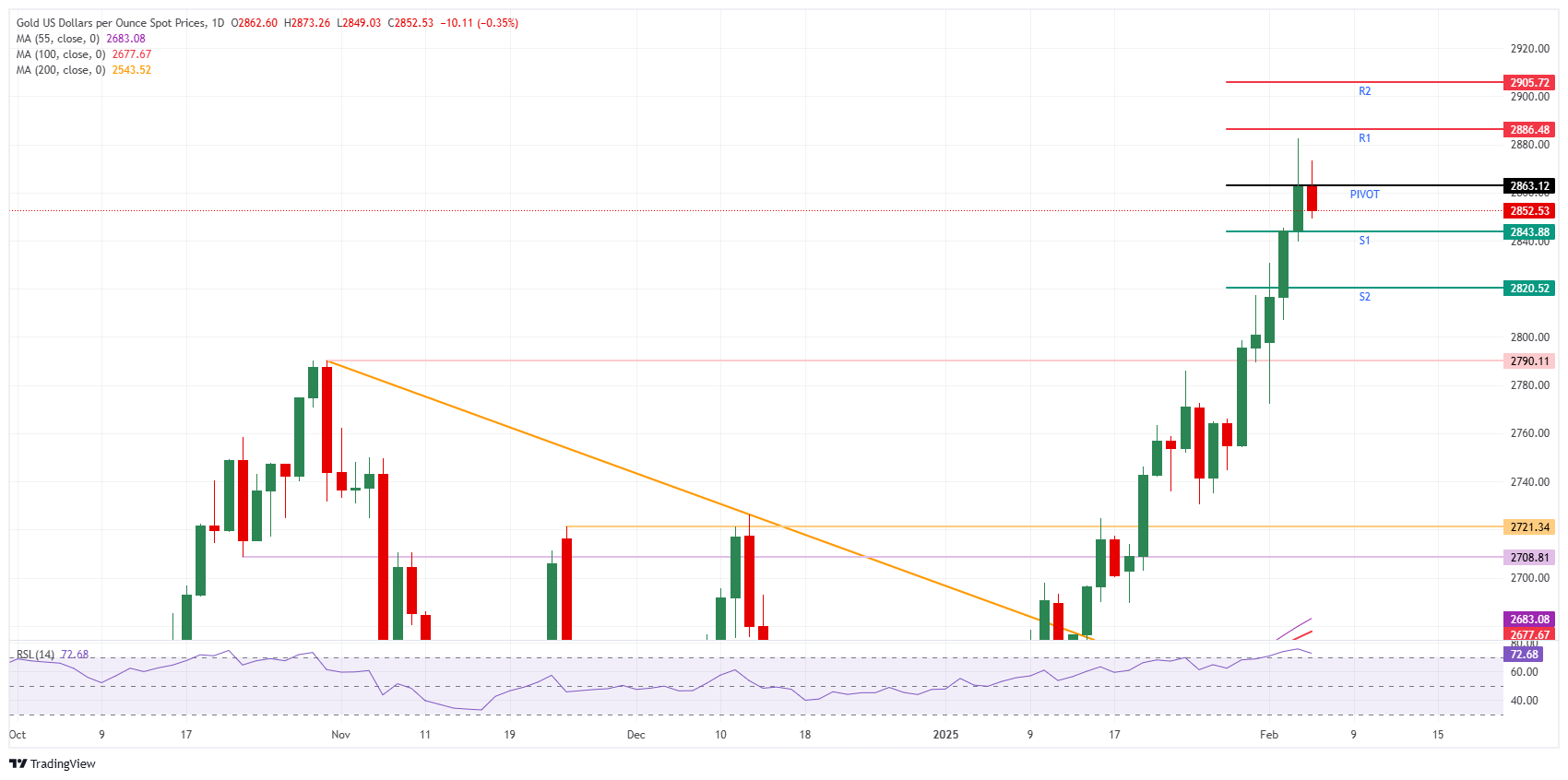Gold rally stalls as US Treasury Secretary Bessent says Trump’s focus is on lowering 10-year yields, not Fed
- Gold’s all-time high currently stands at $2,882.35 printed on Wednesday.
- Bullion caught by surprise after comments from US Treasury Secretary Bessent revealing Trump wants to bring down 10-year yields, not Fed rate cuts.
- Gold snaps winning streak and faces selling pressure this Thursday in Asia.
Gold’s price (XAU/USD) sees its rally stall this Thursday and trades around $2,857 at the time of writing. The slide is mainly triggered by comments from US Treasury Secretary Scott Bessent, who said that the Trump administration's focus is on bringing down 10-year Treasury yields, not the Federal Reserve's (Fed) benchmark short-term interest rate, Bloomberg reports.
On the economic data front, all eyes will be on the Bank of England monetary policy decision, where a 25 basis point (bps) interest rate cut is expected, to 4.50% after cutting it by 50 bps throughout 2024. Besides that, Federal Reserve (Fed) Governor Christopher Waller, San Francisco Fed President Mary Daly and Dallas Fed President Lorie Logan will speak later this Thursday, ahead of Friday’s Nonfarm Payrolls data release.
Daily digest market movers: Gold cracks under profit-taking pressure
- Comments from US President Donald Trump on Gaza and a new nuclear deal with Iran are soothing the tail risk element in the markets, which makes investors pare back some positions in Gold, Bloomberg reports. Trump is also expected to present a plan next week to end the war in Ukraine, which will help to ease the risk premium further.
- Commodity markets are poised to break out of a two-year slump as a rally in precious metal and agriculture prices takes place. The Bloomberg Commodity Total Return Index, which trades a basket of 24 energy, metals, and agricultural futures, has already jumped 5.9 percent this year to its highest level since the end of 2022 – which was a golden year for raw materials as economies returned from COVID-19 hibernation and the war in Ukraine wreaked havoc on supply chains, Bloomberg reports.
- Gold in the Bank of England vault is trading at a discount to the wider market, as fears over potential Trump’s tariffs spark a scramble for bullion that’s resulting in weeks-long queues to withdraw metal, Reuters reports.
- The Bank of England is set to release its monetary policy decision at 12:00 GMT. The expectation is for a 25 basis point interest rate cut from 4.75% to 4.50%.
Technical Analysis: Markets are having it hard to follow
Markets need to change their stance quite quickly, which means that Gold is not in the sweet spot this Thursday. ‘Peaceful’ comments from US President Donald Trump are taking markets by surprise and supporting a more risky stance, which means safe havens are out of favour. With Gold being clearly one of those, selling pressure on Thursday could persist until a contradictory headline or comment comes out.
The S1 support level on Thursday is the first nearby support at $2,8343. From there, S2 support should come in at $2,820. In case of a correction, the bigger $2,790 level (the previous high of October 31, 2024) should be able to catch any falling knives.
On the upside, R1 resistance comes in at $2,886, just slightly above the current all-time high. In case the rally can pick up where it left off, the upside level to beat in terms of daily pivotal levels is R2 resistance near $2,905 after breaking above $2,900.

XAU/USD: Daily Chart
Gold FAQs
Gold has played a key role in human’s history as it has been widely used as a store of value and medium of exchange. Currently, apart from its shine and usage for jewelry, the precious metal is widely seen as a safe-haven asset, meaning that it is considered a good investment during turbulent times. Gold is also widely seen as a hedge against inflation and against depreciating currencies as it doesn’t rely on any specific issuer or government.
Central banks are the biggest Gold holders. In their aim to support their currencies in turbulent times, central banks tend to diversify their reserves and buy Gold to improve the perceived strength of the economy and the currency. High Gold reserves can be a source of trust for a country’s solvency. Central banks added 1,136 tonnes of Gold worth around $70 billion to their reserves in 2022, according to data from the World Gold Council. This is the highest yearly purchase since records began. Central banks from emerging economies such as China, India and Turkey are quickly increasing their Gold reserves.
Gold has an inverse correlation with the US Dollar and US Treasuries, which are both major reserve and safe-haven assets. When the Dollar depreciates, Gold tends to rise, enabling investors and central banks to diversify their assets in turbulent times. Gold is also inversely correlated with risk assets. A rally in the stock market tends to weaken Gold price, while sell-offs in riskier markets tend to favor the precious metal.
The price can move due to a wide range of factors. Geopolitical instability or fears of a deep recession can quickly make Gold price escalate due to its safe-haven status. As a yield-less asset, Gold tends to rise with lower interest rates, while higher cost of money usually weighs down on the yellow metal. Still, most moves depend on how the US Dollar (USD) behaves as the asset is priced in dollars (XAU/USD). A strong Dollar tends to keep the price of Gold controlled, whereas a weaker Dollar is likely to push Gold prices up.

